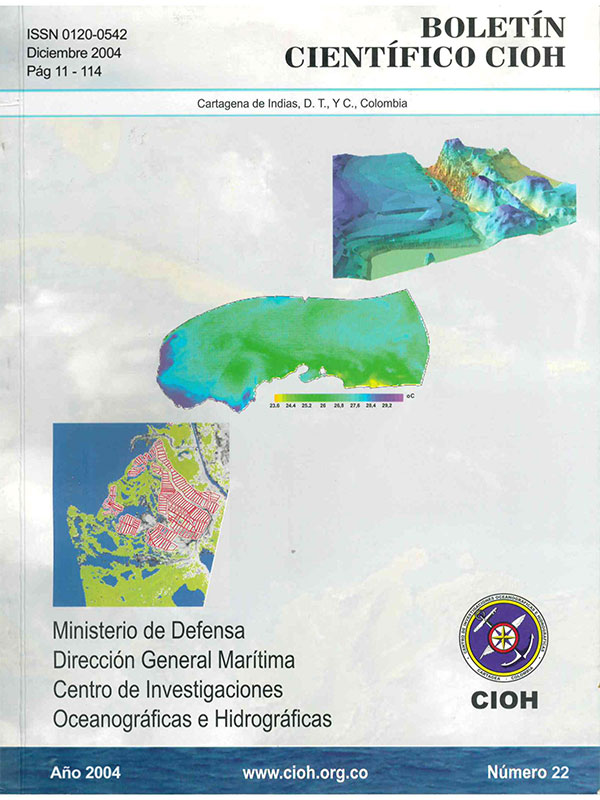Patrones de la pluma turbia del canal del Dique en la bahía de Cartagena
DOI:
https://doi.org/10.26640/22159045.130Keywords:
Cartagena Bay, SPOT images, numerical models, turbidity, Dique ChannelAbstract
The dispersion patterns of the turbid plume of Canal del Dique in Cartagena Bay are described through the analysis of 69 SPOT images and the results of the numerical modeling designed to detect the principal mechanisms for the formation of the turbid plume patterns from the Dique channel at the Cartagena Bay. Six different patterns of the plume were detected based on homologous selection. The implemented hydrodynamic model simulated the turbid plume and identified the hydro-meteorological conditions for each pattern.Downloads
References
Andrade, C., Arias F., y Thomas, F. (1988). Nota sobre la turbidez, circulación y erosión en la región de Cartagena (Colombia). Boletín Científico CIOH, N. 8, Cartagena, pp. 71-81.
Hess, K.W. (1989). MECCA Programs Documentation. NESDIS, NOAA.
Lonin, S. (1994). Simulación de la Circulación y la Dinámica de los Sedimentos en Suspensión en la Zona Somera del Mar Negro. Tesis Ph. D. Universidad Estatal de Hidrometeorología de Rusia, San Petersburgo.
Lonin, S. (1995). Influence of Suspended Matter on Shallow Water Dynamics. Atmospheric and Oceanic Physics, AGU. Vol. 31, N. 4, pp. 577-586.
Lonin, S. y Giraldo L. (1995). Circulación de las aguas y transporte de contaminantes en la Bahía Interna de Cartagena. Boletín Científico CIOH, N. 16, Cartagena, pp. 25-56.
Lonin, S. y Giraldo L. (1996a). Resultados Preliminares del Estudio de la Dinámica del sistema de Caños y Lagunas de Cartagena. Boletín Científico CIOH, N. 17, Cartagena, pp. 17-26.
Lonin, S., y Giraldo L. (1996b). Influencia de los Efectos Térmicos en la Circulación de la Bahía de Cartagena. Boletín Científico CIOH, N. 17, Cartagena, pp. 47-56.
Lonin, S. (1997a). Cálculo de la Transparencia del Agua en la Bahía de Cartagena, Boletín Científico CIOH, N. 18, Cartagena, pp. 85-92.
Lonin, S. (1997b). Hydrodynamic Modelling and the Problem of Oil Spills on the Colombian Caribbean Shoreline. Spill Technology Newsletter, Vol.22(1-4), pp.1-6.
Lonin, S. (1999). Lagrangian model for oil spill diffusion at sea. Spill Science & Technology Bulletin, Vol. 5, N. 5/5-6, pp. 331-336.
Mellor, G. and Yamada T. (1974). A hierarchy of turbulence closure models for planetary boundary layers. J. Atmos. Sci., 31, 1791-1806.
Pagliardini J.L., Gómez M., Gutiérrez T., Zapata S., Jurado A., Garay J., Vernette G. (1982). Síntesis del Proyecto Bahía de Cartagena. Boletín Científico CIOH, N. 4. pp. 49-110.
SHOM. (1984). Table des marèes des grads ports du monde. Paris, SHOM Ed.
Tuchkovenko, Yu.S., Lonin, S.A. y Calero, L.A. (2000) Modelación Ecológica de las Bahías de Cartagena y Barbacoas bajo la Influencia del Canal del Dique. Avances en Recursos Hidráulicos, N. 7, pp. 76-94.
Tuchkovenko, Yu.S., Lonin, S.A. y Calero, L.A. (2002). Modelo de eutroficación de la bahía de Cartagena y su aplicación práctica. Boletín Científico CIOH, N. 20, Cartagena, pp. 28-44.
Tuchkovenko, Yu.S. and Lonin, S.A. (2003). Mathematical Model of the Oxygen Regime of Cartagena Bay. Ecological Modelling, Vol. 165/1, pp. 91-106.
Urbano, J., Thomas, F., Parra, C, y Genet P. (1992). Dinámica de la pluma de turbidez del canal del Dique en la bahía de Cartagena. Boletín Científico CIOH, N. 11, Cartagena, pp. 3-14.
Krone, R. B. (1962). Flume studies on de transport of sediment in estuarine shoaling processes. Hydr. Eng. Laboratory, Univ. of Berkeley, California, USA.
Downloads
Published
Issue
Section
License
Attribution — You must give appropriate credit, provide a link to the license, and indicate if changes were made. You may do so in any reasonable manner, but not in any way that suggests the licensor endorses you or your use.
NonCommercial — You may not use the material for commercial purposes.
NoDerivatives — If you remix, transform, or build upon the material, you may not distribute the modified material.
No additional restrictions — You may not apply legal terms or technological measures that legally restrict others from doing anything the license permits.



